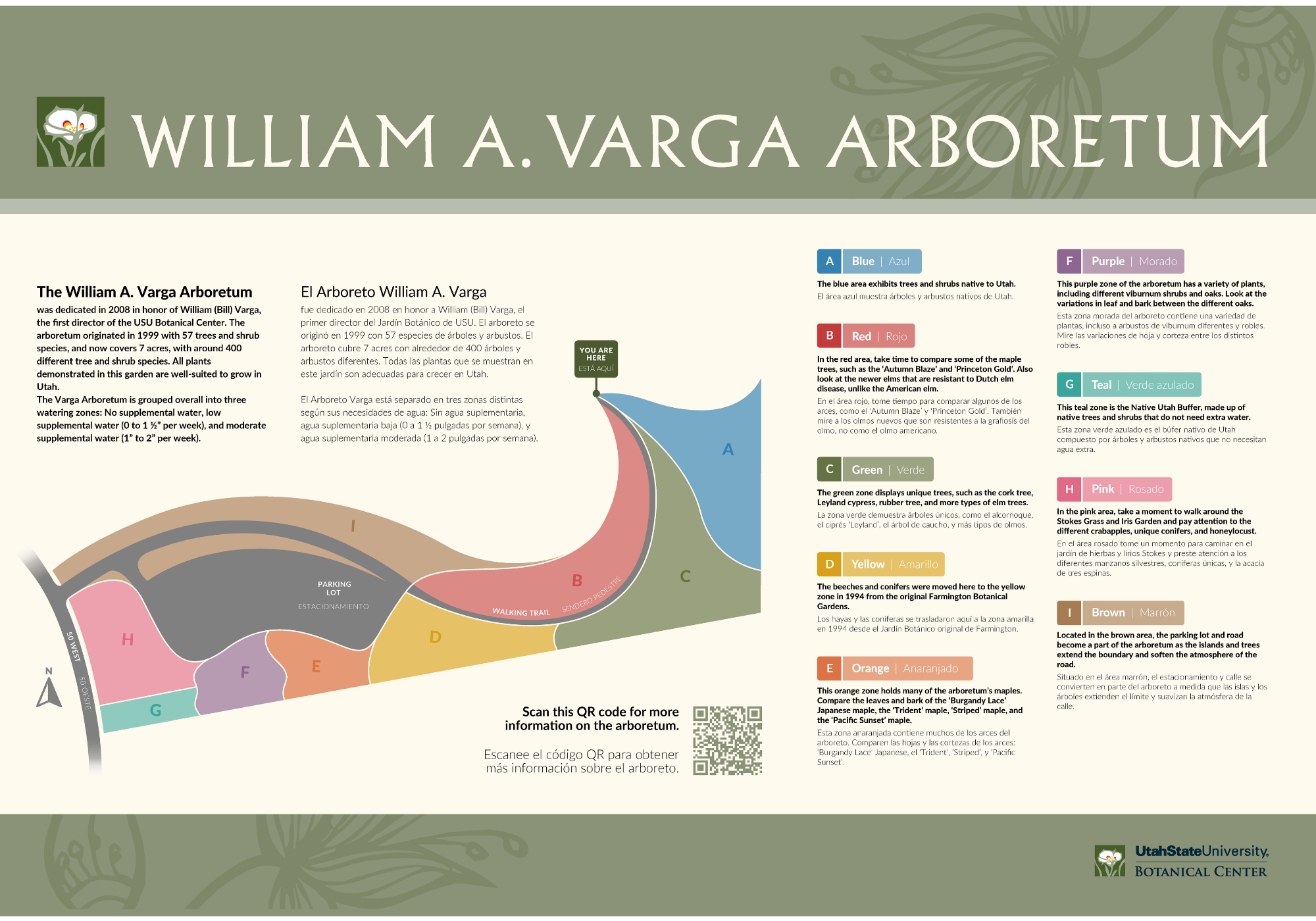The trees and shrubs found in the Varga Arboretum are grouped in three hydrozones, or according to the amount of water they require. The arboretum began in 1999 with 57 trees and shrubs that were moved, under Varga’s direction, from the former USU Botanical Garden in Farmington. During 2008 and 2009, more than 100 newer varieties were added to the original collection. Each year, more trees and shrubs are planted by dedicated USU BC staff and volunteers. Currently, there are around 400 different species highlighted. All plants demonstrated in this arboretum are well-suited to grow in Utah.
Are you looking to add a specific type of tree to your landscape? Visit USU's Tree Browser, an interactive database, to search photos and descriptions of 245 tree species found in Utah and the Intermountain West, many of which are displayed in our arboretum.

A: BLUE (Azúl)
The blue area exhibits trees and shrubs native to Utah. (El área azul muestra árboles y arbustos nativos de Utah.)
- Bigtooth Maple
- Utah Juniper
- Gambel Oak
B: RED (Rojo)
In the red area, take time to compare some of the maple trees, such as the ‘Autumn Blaze’ and ‘Princeton Gold’. Also look at the newer elms that are resistant to Dutch elm disease, unlike the American elm. (En el área rojo, tome tiempo para comparar algunos de los arces, como el ‘Autumn Blaze’ y ‘Princeton Gold’. También mire a los olmos nuevos que son resistentes a la grafiosis del olmo, no como el olmo americano.)
- Jack Pine
- John Pair Sugar Maple
- Lacebark Pine
- Mesa Verde Blue Spruce
- Praire Expedition Elm
- Presidential Gold Ginkgo
C: GREEN (Verde)
The green zone displays unique trees, such as the cork tree, Leyland cypress, rubber tree, and more types of elm trees. (La zona verde demuestra árboles únicos, como el alcornoque, el ciprés ‘Leyland’, el árbol de caucho, y más tipos de olmos.)
D: YELLOW (Amarillo)
The beeches and conifers were moved here to the yellow zone in 1994 from the original Farmington Botanical Gardens. (Los hayas y las coníferas se trasladaron aquí a la zona amarilla en 1994 desde el Jardín Botánico original de Farmington.)
E: ORANGE (Anaranjado)
This orange zone holds many of the arboretum’s maples. Compare the leaves and bark of the ‘Burgandy Lace’ Japanese maple, the ‘Trident’ maple, ‘Striped’ maple, and the ‘Pacific Sunset’ maple. (Esta zona anaranjada contiene muchos de los arces del arboreto. Comparen las hojas y las cortezas de los arces: ‘Burgandy Lace’ Japanese, el ‘Trident’, ‘Striped’, y ‘Pacific Sunset’.)
F: PURPLE (Morado)
This purple zone of the arboretum has a variety of plants, including different viburnum shrubs and oaks. Look at the variations in leaf and bark between the different oaks. (Esta zona morada del arboreto contiene una variedad de plantas, incluso a arbustos de viburnum diferentes y robles. Mire las variaciones de hoja y corteza entre los distintos robles.)
G: TEAL (Verde azulado)
This teal zone is the Native Utah Buffer, made up of native trees and shrubs that do not need extra water. (Esta zona verde azulado es el búfer nativo de Utah compuesto por árboles y arbustos nativos que no necesitan agua extra.)
H: PINK (Rosado)
In the pink area, take a moment to walk around the Stokes Grass and Iris Garden and pay attention to the different crabapples, unique conifers, and honeylocust. (En el área rosado tome un momento para caminar en el jardín de hierbas y lirios Stokes y preste atención a los diferentes manzanos silvestres, coníferas únicas, y la acacia de tres espinas.)
I: BROWN (Marrón)
Located in the brown area, the parking lot and road become a part of the arboretum as the islands and trees extend the boundary and soften the atmosphere of the road. (Situado en el área marrón, el estacionamiento y calle se convierten en parte del arboreto a medida que las islas y los árboles extienden el límite y suavizan la atmósfera de la calle.)

